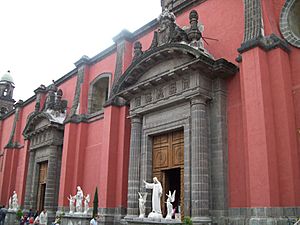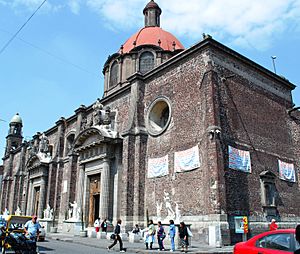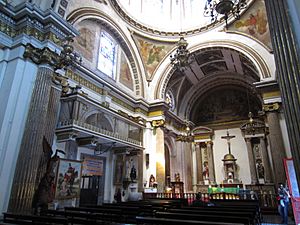Royal Convent of Jesús María and Our Lady of Mercy facts for kids
Quick facts for kids Royal Convent of Jesús María and Our Lady of Mercy |
|
|---|---|
|
Convento Real de Jesús María y Nuestra Señora de la Merced
|
|

The church's exterior, 2012
|
|
| 19°25′55″N 99°07′42″W / 19.4320°N 99.1282°W | |
| Location | Mexico City |
| Country | Mexico |
| History | |
| Founded | 1580 |
The Royal Convent of Jesús María and Our Lady of Mercy (which in Spanish is Convento Real de Jesús María y Nuestra Señora de la Merced) is a historic church located in the center of Mexico City. It started as a special home for girls who didn't have parents or enough money for a dowry (a gift given when a woman got married). It was the third convent of its kind in Mexico City when it was founded in 1580. The King of Spain, Philip II of Spain, even helped pay for it, hoping it would become a very important convent in New Spain (which was what Mexico was called back then).
History
Why the Convent Was Needed
In the 1500s, many girls in Mexico City were orphans or had families who couldn't afford to give them a dowry. This meant they often couldn't get married or join convents, which usually required a dowry to help support them.
To help these girls, a kind person named Pedro Tomás de Denia decided to start a convent. He got help from Gregorio Pesquera, who gave a lot of money. Pedro de Denia also traveled to Mexico's northern mines to raise more funds. Their efforts caught the attention of important leaders like Martín Enríquez de Almanza and Archbishop Pedro Moya de Contreras. The archbishop even asked citizens to donate.
Eventually, enough money was collected. On April 11, 1578, Denia bought a building for the convent. Then, ten nuns from another convent moved in to help run Jesús María. The convent officially opened in 1580 with fifteen girls. It was a home for Conceptionist sisters, becoming the third Conceptionist convent in Mexico City.
Royal Support
Even though they had enough money to buy the building, they needed more for its upkeep. Pedro de Denia went to Spain to ask Philip II of Spain for help. He also asked the Vatican for special religious privileges for the convent, hoping this would make it a popular place for people to visit and donate.
Philip II met with Denia and received a letter from Archbishop Moya de Contreras explaining the convent's needs. The King agreed to provide a large sum of money over twenty years. On February 4, 1583, he declared himself the main supporter of the convent. He also ordered that Archbishop Moya de Contreras would be in charge of all matters related to the convent. Philip II even asked the Pope to make Jesús María the most important chapel in New Spain for receiving special blessings.
Historian Carlos de Sigüenza y Góngora wrote that King Philip II was very eager to support the convent because his daughter, Micaela de los Ángeles, was living there. Micaela was also Archbishop Moya de Contreras's niece. She had come to New Spain with the archbishop when she was two years old. She first stayed at another convent, but when Jesús María opened, she moved there. Micaela was twelve years old when the convent was formed.
Building Changes Over Time
The convent building started to get bigger on March 15, 1597, during the time of Gaspar de Zúñiga, 5th Count of Monterrey. According to Sigüenza y Góngora, the construction cost a lot of money.
Later, on February 16, 1621, the building was changed into a temple by Diego Fernández de Córdoba, 1st Marquess of Guadalcázar. In 1892, the building started to show signs of age and was rebuilt in a new style called neoclassical architecture.
On April 1, 1933, the government issued an order that stopped religious ceremonies there, and the temple was closed. Today, the former temple is still used as a church in the historic center of Mexico City.
See also
 In Spanish: Convento de Jesús María (Ciudad de México) para niños
In Spanish: Convento de Jesús María (Ciudad de México) para niños
- List of colonial churches in Mexico City





